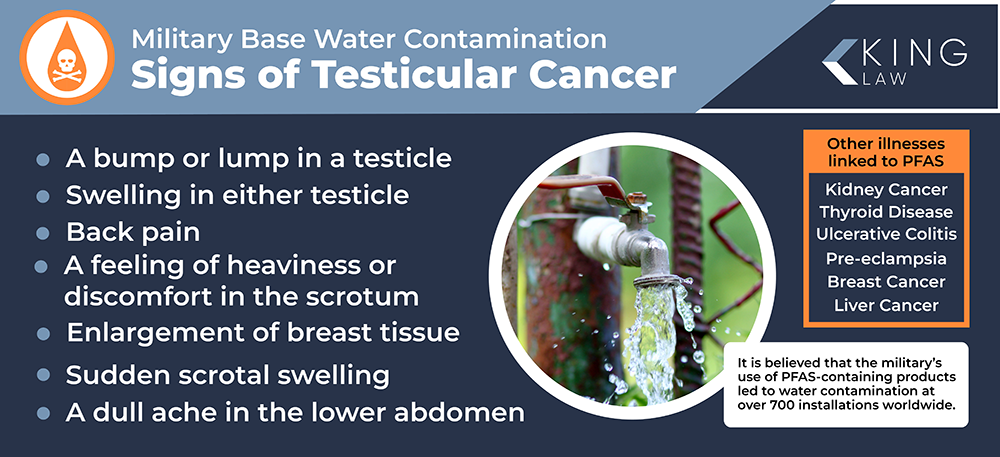
Testicular Cancer Linked to PFAS During Military Service
Testicular cancer is one of the leading types of cancers affecting men between the ages of 15 and 44 years old. It can spread quickly but has a high survival rate. While many causes of testicular cancer remain unknown, studies show that prolonged exposure to per- and polyfluoroalkyl substances (PFAS) may increase the risk.
The U.S. Department of Defense (DoD) recently announced that over 700 military installations across the globe may contain PFAS and need to be assessed. The presence of PFAS chemicals at these sites may have put military service members at an increased risk for developing testicular cancer and other adverse health conditions.
Table of Contents:
Testicular Cancer Linked to PFAS During Military Service
The Prevalence of Testicular Cancer and PFAS Exposure Among Military Personnel
PFAS Exposure and Its Link to Testicular Cancer
Testicular Cancer: Prevention and Early Detection
Rights for Servicemembers with Testicular Cancer Due to PFAS Exposure
Resources for Military Personnel Exposed to PFAS
PFAS Legislation and Water Contamination Awareness
The Prevalence of Testicular Cancer Among Military Personnel
Men have about a 1 in 270 chance of developing testicular cancer, and it is typically diagnosed at around age 33, according to Johns Hopkins Medicine. Risk factors include abnormal testicular cells, family history, and exposure to toxic chemicals.
A new study reported on by PBS indicates that there may be a direct link between exposure to PFOS (a known PFAS chemical) and testicular cancer among military personnel. The study looked at the blood of thousands of Air Force servicemen. It found that airmen who had been firefighters had a higher level of PFOS in their bloodstream. It further found that the servicemembers with testicular cancer had higher levels of PFOS.
PFAS Exposure and Its Link to Testicular Cancer
For decades, the military used aqueous film forming foam (AFFF), a fire-fighting foam known to contain PFAS. Research dating back to the 1970s confirms that PFAS are dangerous and that men like civilian and military firefighters who had known prolonged and repeated exposure to PFAS had higher rates of testicular cancer compared to the general population.
Not only have military service members been exposed to PFAS within the course of their work, but also at the bases where they live. The DoD is currently working to assess over 700 installations they believe could have some level of PFAS, in many cases involving contaminated water at the military bases.
Thousands of lawsuits have been filed against manufacturers of PFAS-containing fire-fighting foam. Over the past few years, an increasing number of studies, including new federal research, confirm a direct link between PFAS exposure and testicular cancer in military personnel, strengthening these lawsuits for the plaintiffs.
Symptoms of Testicular Cancer
As reported by the Mayo Clinic, the first sign of testicular cancer is frequently a bump or lump on the testicle, but there are many other signs and symptoms that should be taken seriously.
If you have been exposed to PFAS-contaminants at a military base, you need to look out for these potential signs of testicular cancer:
- A bump or lump in a testicle
- Swelling in either testicle
- Back pain
- Enlargement of breast tissue
- A feeling of heaviness or discomfort in the scrotum
- A dull ache in the lower abdomen
- Sudden scrotal swelling
Testicular cancer has a 95% survival rate but it can spread quickly. It is imperative to have any signs or symptoms evaluated by a medical professional as early as possible.

Testicular Cancer: Prevention and Early Detection
Because of the prevalence of testicular cancer in military personnel who have been exposed to PFAS, it is strongly advised that service members receive routine screenings. Routine screenings can help with early detection and treatment.
The Testicular Cancer Awareness Foundation recommends performing self-exams to help identify any changes in your testicles. Suspected abnormalities, such as a lump or swelling, should immediately be evaluated by a doctor. You can also receive blood tests that can help monitor the level of PFAS in your bloodstream over time.
Rights for Servicemembers with Testicular Cancer
Servicemembers and veterans who have developed testicular cancer due to PFAS exposure may have a number of legal options to obtain compensation for their damages. It is important to work with a qualified attorney to determine the best course of action moving forward. Law firms focusing on PFAS lawsuits have played a pivotal role in advocating for the rights of victims and in securing financial recovery on their behalf.
Recent legislation has helped to ensure veterans receive access to health care and benefits if they were exposed to toxic substances during their service. The Sergeant First Class (SFC) Heath Robinson Honoring our Promise to Address Comprehensive Toxics (PACT) Act substantially adds to the number of presumptive conditions the U.S. Department of Veterans Affairs (VA) presumes occurred as a part of your service. Military service members will no longer have to prove that their presumptive condition (including testicular cancer) was caused by exposure to burn pits, Agent Orange, or other toxic substances.
Resources for Military Personnel Exposed to PFAS
Military personnel who have been exposed to PFAS have a number of resources and support groups that they can access. It is important to reach out if you or a loved one is struggling. Diagnosis of a serious condition can be challenging, but there is support and legal assistance available.
Resources for military personnel exposed to PFAS:
- Testicular Cancer Awareness Foundation
- HunterSeven Foundation
- Disabled American Veterans
- FisherHouse Foundation
- File a claim for disability with the VA
- Enrollment application for VA healthcare benefits
Early detection is often critical in securing a positive outcome after a testicular cancer diagnosis. Working with an experienced attorney can help ensure that you not only receive all of the benefits that you are entitled to but that you also help hold liable parties accountable for any wrongdoing.
PFAS Legislation and Water Contamination Awareness
Legislation, including the PACT Act, has helped to ensure that military servicemembers will receive the access to healthcare that they need and deserve. As more and more studies link exposure to PFAS and an increased risk in the development of certain cancers, there has been a change in DoD’s policy on the use of PFAS in military operations.
The DoD has identified 715 military installations that require an assessment of per- and polyfluoroalkyl substances (PFAS). The sites are located across the globe, meaning that most military personnel may have been exposed to dangerous contaminants during their service.
While the DoD is in the process of assessing and cleaning up these bases, they have also restricted the use of AFFF, a fire-fighting foam known to contain PFAS. Furthermore, AFFF is prohibited for use by the military past October 1, 2024, unless granted an exception by the Secretary of Defense.
Contact a PFAS Cancer Lawyer Today
Were you diagnosed with testicular cancer after serving in the U.S. military? You may be entitled to compensation. Contact King Law to schedule a free, no-obligation consultation. Our firm has successfully handled numerous military PFAS and water contamination cases. Get the legal help you need now.

